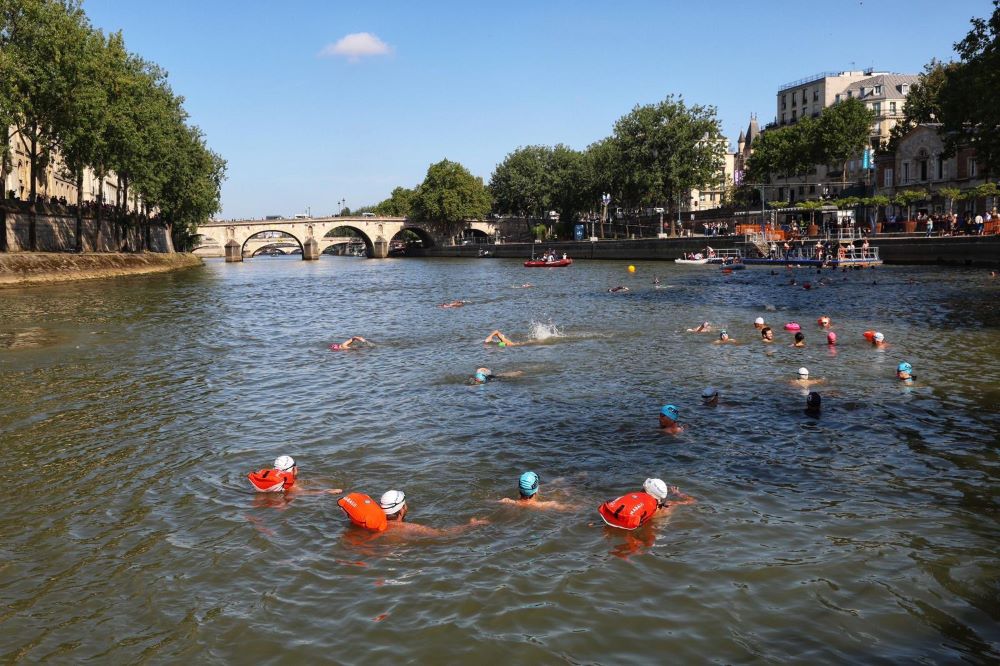Seine swimming: Parisian tradition resurrected for Olympics
1.4 billion euros ($1.5 billion) has been invested to make the Seine and its main tributary, the Marne, swimmable.

Paris, France- Paris Mayor Anne Hidalgo took the plunge July 16 when she jumped into the River Seine in Paris to show the water was clean enough to host Olympic swimming events starting later this month.
Hidalgo is the latest VIP to cleave through the river's murky waters, after Sports Minister Amelie Oudea-Castera on July 13.
Despite a major clean-up, many Parisians still recoil at the idea of swimming in a river that regularly tests for high levels of bacteria caused by faecal matter.
La baignade dans la Seine, certains en ont rêvé, beaucoup en ont douté, et nous, nous l'avons fait !
— Paris (@Paris) July 17, 2024
Après 100 ans d'interdiction, les athlètes feront le grand saut à leur tour dans quelques jours pendant les Jeux ! Ce sera dès l'été prochain pour tous les Parisiennes et les… pic.twitter.com/VuZjWeNUqa
But up until 1923, when it was banned due to pollution and the danger from passing river barges, it was a popular pastime.
Here is a brief history of Seine swimming:
17th-century skinny dipping
In the 17th century, before the revolution that toppled France's monarchy, bathing in the Seine was a fashionable pastime -- and one that was often conducted naked.
By the end of the century, skinny dipping had been outlawed, but Seine swimming remained popular, with floating pools installed along the banks.
The most famous of these was the Deligny pool, erected in 1801 on a dozen barges and named after one of the first lifeguards to give bankside swimming lessons.
There were some twenty such spots at various points along the river by the end of the 19th century, before they all fell into disuse with the arrival of land-based pools.
1923: banned
Some diehards continued to slip on their speedos until the practice was officially banned in 1923. Even today, a brigade patrols the waters for any divers.
At times exceptions have been made for Seine swimming, including during heatwaves in the 1940s and official races.
1988: Mayor's promise
When 5,000 pike were released into the river in 1988, Jacques Chirac as mayor of Paris declared that in five years, Parisians would again be able to swim in the Seine.
"I'll come with towels and antibiotics," quipped the environment minister at the time, Brice Lalonde.
Chirac repeated his pledge two years later in an interview on French television, adding that he would personally take a public dip in 1993, though he never did before his death in 2019.
2024: Olympics comeback
Current Paris Mayor Anne Hidalgo revived the dream when bidding for the French capital to get the 2024 Games, promising swimming events in the Seine.
She also added another post-Games goal, to install three summer bathing areas for the general public by the summer of 2025 -- one near Notre Dame, another near the Eiffel Tower and a third at Bercy, a quieter neighbourhood in the east.
Some 1.4 billion euros ($1.5 billion) has been invested to make the Seine and its main tributary, the Marne, swimmable, notably by improving waste water collection management.
A key feature of the project involved building a massive underground rainwater storage tank near Austerlitz train station to hold excess waste water to ensure it does not flow into the Seine.
It hasn't been all plain sailing. Last month Hidalgo was forced to call off a swim because of high levels of fecal matter.
The swimming leg of the Olympics triathlon is set to take place in its waters on July 30-31 and Aug. 5, followed by the open-water swimming on Aug. 8-9.


 AFP
AFP


.jpg)
.jpg)
.png)
.png)

.png)

.png)
.jpg)

Comments
Start the conversation
Become a member of New India Abroad to start commenting.
Sign Up Now
Already have an account? Login